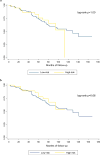Treatment Strategies in Octogenarians with Early-Stage, High-Risk Breast Cancer
- PMID: 29427213
- PMCID: PMC5930070
- DOI: 10.1245/s10434-018-6350-8
Treatment Strategies in Octogenarians with Early-Stage, High-Risk Breast Cancer
Abstract
Background: Octogenarians with early-stage breast cancer often have low-risk tumor biology. However, optimal treatment strategies for those with high-risk biology remain unclear.
Methods: We reviewed the records of women ages 80-89 years with biopsy-proven, Stage I-II invasive breast cancer who were referred for surgical evaluation from January 2001 through December 2010. High-risk was defined as human epidermal growth factor receptor-positive (HER2+), triple-negative (TN), or histologic grade 3 disease.
Results: Among 178 patients, 40 (22%) were high-risk: 12 were grade 1-2 (10 HER2 + , 2 TN); 28 were grade 3 (7 HER2+, 6 TN, 15 estrogen receptor-positive (ER+)/HER2-). The high-risk group had larger tumors and more often had ductal histology and lymphovascular invasion than the low-risk group and was more likely to undergo mastectomy (18 vs. 5%, p = 0.02), radiotherapy (55 vs. 36%, p = 0.03), and chemotherapy (10 vs. 0%, p = 0.002). Endocrine therapy use was similar among ER+ patients in both groups. The four patients in the high-risk group given chemotherapy were HER2+ and received trastuzumab-based regimens, without any reported toxicities. At median follow-up of 67 months, 10% of the high-risk group had a recurrence (3 distant-only, 1 simultaneous locoregional and distant in a patient treated with mastectomy without radiotherapy).
Conclusions: Tailored locoregional and systemic therapy resulted in low incidence of failure in these octogenarians with high-risk cancers with low morbidity. Modern adjuvant therapies should be considered for elderly women with high-risk cancers in the absence of significant comorbidities.
Conflict of interest statement
Figures
Comment in
-
How Old is Too Old? Breast Cancer Treatment in Octogenarians.Ann Surg Oncol. 2018 Jun;25(6):1458-1460. doi: 10.1245/s10434-018-6457-y. Epub 2018 Apr 9. Ann Surg Oncol. 2018. PMID: 29633098 No abstract available.
-
ASO Author Reflections: Eighty is the New Sixty-Breast Cancer Treatment Strategies in the Octogenarian Patient Population.Ann Surg Oncol. 2018 Dec;25(Suppl 3):697-698. doi: 10.1245/s10434-018-7071-8. Epub 2018 Nov 21. Ann Surg Oncol. 2018. PMID: 30465223 No abstract available.
References
-
- Angarita FA, Chesney T, Elser C, Mulligan AM, McCready DR, Escallon J. Treatment patterns of elderly breast cancer patients at two Canadian cancer centres. Eur J Surg Oncol. 2015;41(5):625–34. - PubMed
MeSH terms
Substances
Grants and funding
LinkOut - more resources
Full Text Sources
Other Literature Sources
Medical
Research Materials
Miscellaneous


